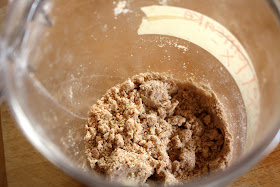Okay, on to the reason for the aforementioned title: For the last couple weeks ago, I've been sort of arguing with myself on whether or not it's too early to start doing posts on here about gardening. On one hand, a good part of the country is still buried under lots of snow (though, not so much here, oddly enough, where we boast about having 'the greatest snow on Earth'. Go figure.). Then again, there's this weekly gardening call-in show on the radio every Saturday and they still talk about gardening during the winter months. Anyway, I've finally come to the conclusion that it is, indeed, time for the gardening posts. Being the enthusiastic gardening aficionada that I am, I'm pretty excited to get started. We've only just begun...
A few things brought me to this conclusion. One thing is that the first of my tulips are peeking out from my flower bed. Everyone should plant bulbs - whether in flowerbeds or in containers - purely for the psychological benefit. It's a well-known fact that more people are depressed during the winter months; bulbs are good for the mind because they're a physical reassurance that winter will, in fact, end and that warm weather is in the near future. I've given this much thought, as you can tell.
The second thing: my pussywillow. It's so close to blooming with those soft, white buds. Again, if you have a yard, you should plant these purely for the same reasons I suggest planting bulbs. It just does something to your soul to see life emerge from the cold, dingy brownness that is Februrary.
And finally, the thing that really got me to start posting gardening stuff again was that the gardening workshops in my area have started again. Hey, if they're ready to go, why not me and this blog? It just so happens that I attended the first workshop of 2010, so I'm going to share the handout from the class I attended called,
"Wake Up Your Garden!"
First of all, I don't want anyone feeling left out if you don't have a yard or garden area. That goes for people that profess to have a 'black thumb', too. I promise, I will help you the best I can through your gardening endeavors as the season progresses and give you ideas on how to adapt to your situations. It's a tall order, I know, but I will do that for you (are you feeling the love?). This post is just a quick overview - a sort of check-list - of how to get ready for the season ahead; more in-depth info, how-to, and details to come in the weeks ahead.
Step #1: Planning and Preparation
- Make a plan of your garden site, including space and sun exposure. Graph paper is great for planning your garden area. If you already have a garden, start planning what you want to grow over the course of the year. Consider what worked for you last year and what didn't. If you don't have a yard or have a very small one, start thinking about alternative ways to garden: is there room somewhere on a patio or balcony for some containers? If so, think about what you would like to grow (peas? tomatoes? herbs?) - I had a lot of success with container gardening last year.
- Select plants that grow well in your locality and planting zone. Your planting zone is an excellent guide in knowing what will grow (and what won't) in your part of the country. If you don't know what zone you live in, go to this link to the National Gardening Association and enter your zip code. It will not only tell you what zone you live in, but the site has lots of great information and resources.
- Order from seed catalogs if local nurseries don't carry what you need. Here's a site I found about some of the best seed catalogs out there. Just about every company I know of will send you a free catalog.
- Clean and sharpen your garden tools. If you don't have any, go get the basics. You can find a good list of what to get here.
- Rake up leaves and dead grass. Clear out annual and perennial tops.
- Inspect non-plant items like pots, grow boxes, trellises, fences, sprinklers; repair or replace as needed.
- Organic matter should be added every year, dug in or as mulch on top.
- Don't work the soil until it is dry enough. One way to tell: grab a handful of soil and make a ball. If it breaks apart when it hits the ground, it is dry enough; if it falls to the ground with a thud, it's still too wet. You don't want to use too-wet soil because it will be too compact for the air and nutrients to get to your plants, plus it will make your seeds rot.
- Aerate lawn (if applicable). Core aeration is most effective. Do it in the spring OR fall.
- Fertilize. Lawns need high nitrogen (N); pre-emergent is useful in early spring. Fertilize bulbs after they bloom; fertilize perennials when 2-3 inches tall.
- Clean up of dead material (i.e. leaves, perennial and annual tops, etc.) will help keep pests under control.
- Annual weeds - hoe when small. Pre-emergent herbicides are effective.
- Perennial weed - pull the entire root! Most susceptible to herbicides when young.
- Pruning stimulates growth and determines the shape of the plant. Prune after coldest part of winter is past.
- Prune shade and ornamental trees very little - only diseased and broken branches.
- Prune fruit trees according to type, leaving strongest branch angles. (Pruning fruit trees is important, but tricky. Do your research or take a class first. I'm taking a class next month - I'll share the info with you.)
- Roses should be shaped and thinned, with all dead material removed. Leave 3-5 sturdy canes.
- Cut off tops of perennial ornamental grasses.
- Prune spring flowering shrubs (like lilac and forsythia) after they're done blooming.
- Start seeds for transplant, counting back from outside planting time. (More on seed starting in posts to come)
- Plant cool season vegetables mid-March to early April: broccoli, peas, onions, cabbage, lettuce, spinach, potatoes
- Plant cool season annuals in early April: pansies, primrose, stock
- Plant bare-root trees, shrubs, roses, raspberries, blackberries, and strawberries in mid-March or early April.
- You can get an early start on lots of vegetables and fruit by warming the soil with plastic mulch, wall-o-water, and/or cold frame.
One other thing: I would LOVE any feedback, at any time, with gardening questions - general or specific. You can leave your question or concern in a comment or email me (my address is on my profile). I'm no expert, but I feel like I'm a pretty competent gardener. And if I can't answer a question, my mom is a certified Master Gardener and knows even more than I do. Plus, I go to lots of classes and workshops, so there are plenty of super-smart people I can ask. So, send me your concerns and questions. I'll do the best I can. One stipulation: don't ask me anything about lawn care. My lawn is the bane of my existence (well, that and shopping for pants). No matter what I do, it always gets brown and weedy in patches. But anything else, I'm all ears...




















